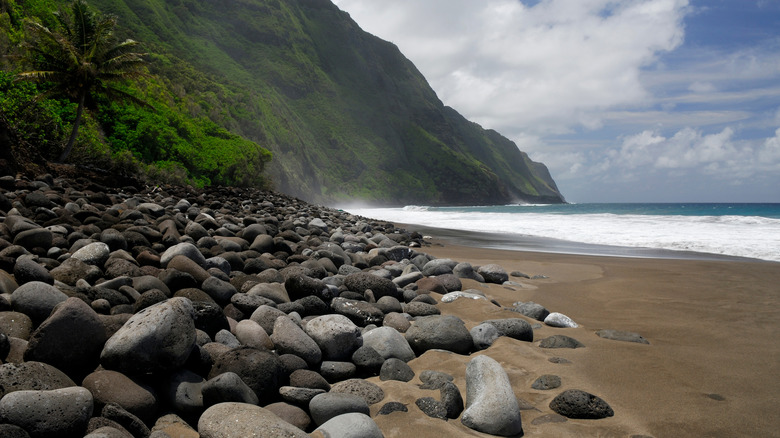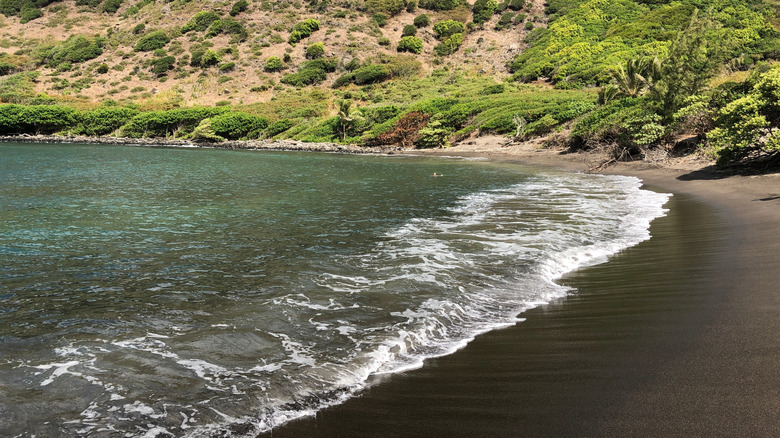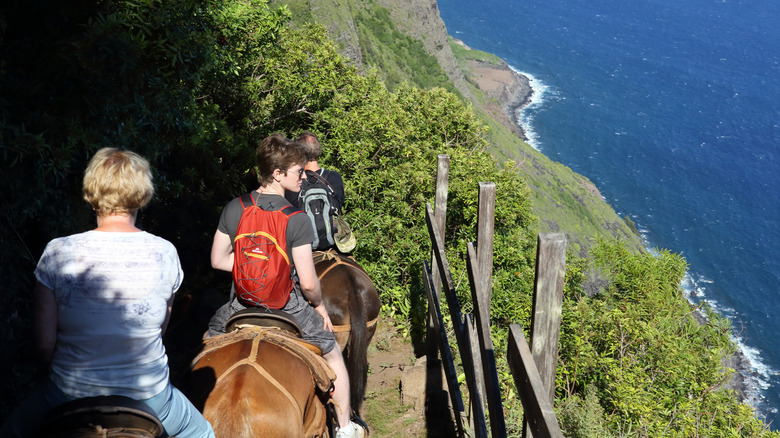Hidden On Hawaii's Moloka'i Island Is A Secret Black Sand Beach With Unique Beauty And No Crowds
Nestled amidst the remote and rugged northern shores of Moloka'i, one of the lesser-visited hidden gem Hawaiian islands with pretty beaches and cliffside views, lies a secret beach where you can go to escape the usual tourist traps and overwhelming crowds. While Moloka'i has no shortage of picture-perfect towns that capture the Hawaiian spirit, travelers in search of quieter locations can find their zen at Awahua Beach, an uncrowded oasis located along the base of the Kalaupapa Peninsula that is sure to take your breath away in more ways than one.
Being one of the less touristy Hawaiian islands, Moloka'i is already pretty isolated, with only about 8,000 inhabitants on the island. This is great news for the threatened and endangered species that live on the island, like green sea turtles and monk seals, that require a safe haven from the more frequented tourist meccas. Volcanic activity and seismic disturbances throughout the years have created the dramatic landscape seen on the island today, like the steep cliffs of Kalaupapa that visitors have to brave to get to this powerfully quiet and remote beach.
It's difficult to make your way into Awahua Beach, but not impossible. Visitors need a written permit or be part of a group to access it, as the terrain is dangerously steep and on protected land. The 3-mile hike down the cliffside trail offers spectacular views overlooking the beach below. You'll zigzag through wooded mountain terrain before arriving at the beautiful black sands of Awahua. Once you reach the bottom of the winding rocky trail, you will be amazed when you gaze back up at the majestic green cliffs that envelop you, unable to fathom just how isolated you truly are on this exotic island.
Rocky sands make for breathtaking beauty
Seeing the unusual landscape of Moloka'i's Awahua Beach for the first time can feel like arriving in another world. This untamed stretch of shoreline is the perfect location to experience the island's unadulterated natural beauty, including black sand beaches and lush tropical greenery.
Awahua's dark-colored sand is formed from sandstone rocks eroded into smaller particles instead of from traditional volcanic activity like other black sand beaches, such as Hawaii's breathtaking Punalu'u sanctuary, which also houses endangered sea turtles. The eroded sandstone contributes to the sand's rough, grainy texture — setting it apart from other beaches on the island. Look closely and you'll see all the different sizes and textures of the black sand rocks that decorate the shore.
The sand on Awahua Beach isn't the only rough feature adorning this peculiar oasis. Swimming at this beach is extremely dangerous and not at all recommended, as there are rip currents that can drag even experienced swimmers out to sea. It's not suggested for wading or surfing either; besides deadly rip currents, there is a sudden steep drop-off into the deep ocean very close to the shoreline, caused by the fact that the beach doesn't have a protective reef. This also opens up the possibility of shark attacks close to shore. While the typical tourist wouldn't visit this beach for a fun day of snorkeling and swimming with the kids, visitors can experience a once-in-a-lifetime view from this intimate, secluded black sand beach surrounded by 2,000-foot cliffs (some even go up as high as 3,900 feet).
This former leper colony is accessible by mule
On top of being on a less-touristed peninsula, Kalaupapa is the most isolated place within Moloka'i. With no roads connecting it to the rest of civilization, the only option is a steep mule mountain trail that involves a 1,700-foot descent with 26 jagged switchbacks. It's not exactly speedy or convenient, but perhaps a good design, considering Kalaupapa's history as a leper colony.
Kalaupapa became an isolated leper colony in 1866 because of its remote location and the ease with which officials were able to quarantine the afflicted. Today, visitors can reach this once-quarantined beach by either hiking down the challenging trail on a guided tour or riding down on the back of a trusty mule. Access to Awahua Beach is via Pala'au State Park, where beachgoers can enjoy other activities like hiking and camping, and even view the beach from a scenic lookout point. If you are looking to travel in style and get a bird's eye view of the precarious cliffs along the island's north shore without having to break a sweat, aerial tours over West Maui and Moloka'i are also available by helicopter.
There are no direct flights to Moloka'i from the United States mainland or any other place in the world except Honolulu or Maui. After arriving at these Hawaiian travel hubs, travelers can then island-hop by flying Mokulele Airlines. The best way to get around Moloka'i is to rent a car and explore the island at your own pace, so you can pull over and get those breathtaking panoramic shots whenever you get the urge. While there is no public transport like buses or trains, a taxi service is available around the island.


